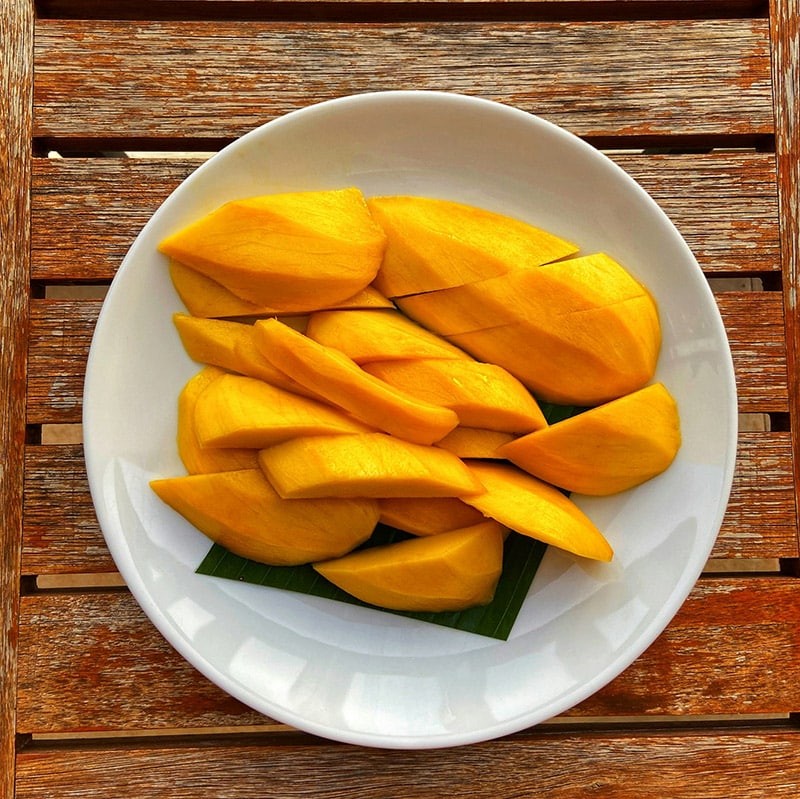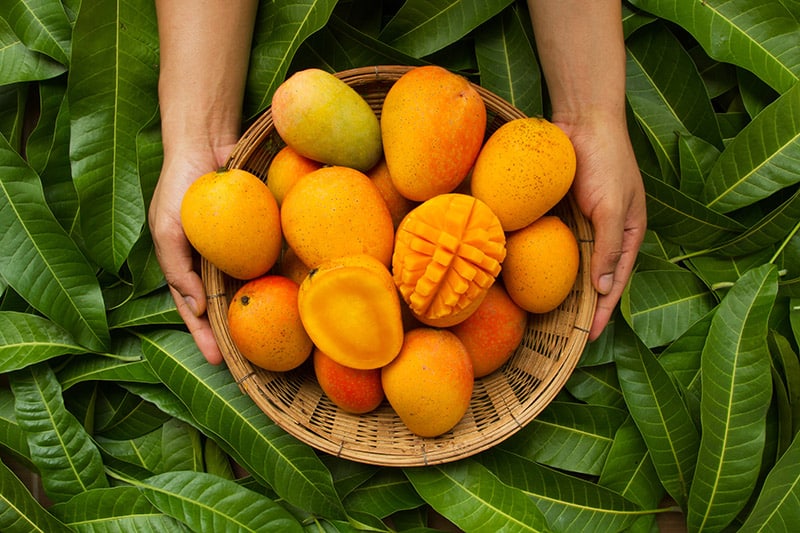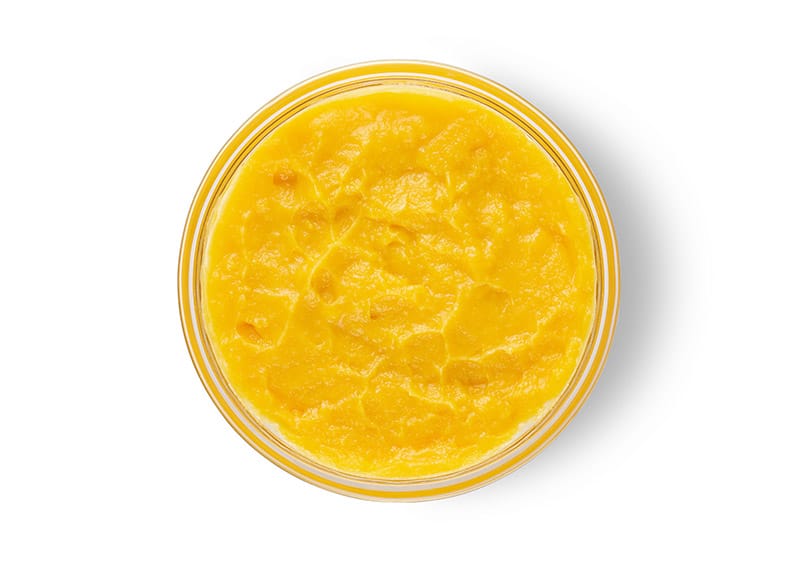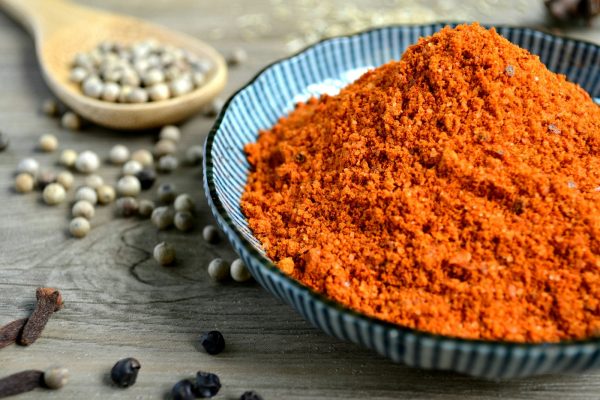In this article
No matter what you’re eating, your dog likely stares on with envy. Most dogs love to eat what their humans eat, but dogs have no idea if the food is good or bad for them or possibly even downright toxic—this is where you must know what human foods you can safely feed your dog.
If you’re a mango connoisseur and always have plenty in the fruit bowl, you may wonder if you can feed some to your dog. Can dogs eat mangoes? Is it safe? Yes, dogs can occasionally have mango as a treat, and the fruit even has some nutritional benefits. Read on to learn more!

Why Can Dogs Eat Mango?
Mangoes are non-toxic to dogs and even have some health benefits, which we’ll discuss in more depth below. Mangoes are delicious, sweet, and easy to peel and cut. However, they should only be given as an occasional treat and in moderation. Despite being safe and healthy for dogs, too much can cause health issues (more on that later).

Benefits of Feeding Mango to Dogs
As mentioned, mango is safe to feed your dog in moderation and even has a few health benefits. For starters, mango is high in both soluble and insoluble fiber, which are good for your pup’s digestive tract. It also contains essential vitamins, such as vitamins A, B6 and E. Vitamin C is high in mangoes, but dogs are able to synthesize their own vitamin C from glucose, so consuming vitamin C isn’t essential for them. The fruit also contains potassium, an important mineral responsible for proper muscle and nerve function. Given the fruit’s sweetness, your dog will love the sweet treat. A bonus is it’s actually good for them (in moderation).
Possible Dangers of Feeding Your Dog Mango
Even though mango is safe to feed your dog, dangers still lurk if fed too much. For example, too much mango may cause stomach upset due to the high natural sugar content, resulting in diarrhea or vomiting. Diabetic dogs should not have mangoes due to their high sugar content.

Signs of Too Much Mango
If your dog eats too much mango or got into your mango stash and helped themself when you weren’t looking, it’s important to know the possible signs of illness.
- Fatigue
- Decreased appetite
- Depression
- Vomiting
- Diarrhea
- Gulping, licking the lips, objects, or the air
- Blood in stool or vomit
If you notice any of these signs, it is advisable to see your vet.
If you need to speak with a vet but can't get to one, head over to PangoVet. It's an online service where you can talk to a vet online and get the personalized advice you need for your pet — all at an affordable price!
Can Dogs Eat Dried Mango?
Feeding store-bought dried mango is not advisable due to the higher sugar content, added preservatives, and other potentially harmful ingredients. You may feed dried mango if you prepare it yourself at home without all the harmful extras, like added sugar. Even so, if you prepare dried mango at home, give your dog smaller portions due to the increased sugar content.

How to Feed Your Dog Mango
First and foremost, peel the mango and remove the pit before giving any to your dog. The pit can become stuck in a dog’s throat which can be a choking hazard. If swallowed, a mango pit can cause a gastro-intestinal obstruction which can quickly become fatal.
So, remove the peel and the pit and offer only small pieces of the flesh of the mango. You can feed small portions of mango once a week, but how much you can safely feed depends on your dog’s size. Let’s break it down.
- Extra-Small Dogs (2–20 pounds): 1–2 pieces (1/2-inch wide by ¼-inch thick)
- Small Dog (21–30 pounds): 2–3 pieces (1/2-inch wide by ¼-inch thick)
- Medium Dog (31–50 pounds): 5–6 pieces (1/2-inch wide by ¼-inch thick)
- Large Dog (51–90 pounds): Handful of pieces (1-inch wide by ¼-inch thick)
- Extra-Large Dog (91+ pounds): Large handful pieces (1-inch wide by ¼-inch thick)
Raw

Raw mango is the easiest way to serve your pooch the delicious, sweet fruit. However, ensure you cut the pieces in the suggested amounts above, and remember to remove the peel and pit!
Frozen Mango

You can also freeze a couple of pieces as a special treat. Placing them inside a Kong toy and freezing the contents can give your dog a fun and tasty treat to work on. Frozen mango serves as a refreshing treat during hot summer days, too.
Mashed

You can mash up the mango pieces and mix them with your dog’s food. You can also freeze the masked pieces if you wish.
Smoothie

Blend mango in a blender with other healthy fruits, like blueberries, strawberries, or bananas, for a healthy smoothie treat.

Final Thoughts
Mango is perfectly fine to feed your dog in moderation, and your dog will love the sweet taste while reaping the health benefits. Refrain from feeding mango to a diabetic dog due to the high sugar content, and if your dog has any other medical issue, consult your veterinarian before feeding mango to your pooch. To keep your dog safe, keep mangoes and other food items out of reach so your dog cannot access them.
Featured Image Credit: Desirae Hayes-Vitor, Unsplash



















2 Responses
What an excellent and detailed post on feeding mangoes to dogs! 🥭 As a pet parent, I always want the best for my furry companion, and your vet-approved tips make it so much easier to understand what's safe and beneficial. I truly appreciate the thoughtful breakdown of benefits, risks, and feeding suggestions. Your commitment to sharing reliable and well-researched information is truly admirable! 🐕❤️
I’ve also found similarly valuable content on Dogs Life Hacks, especially their insights on the benefits of blueberries for dogs. I encourage fellow dog lovers to check it out too! Thank you for helping us keep our pets happy and healthy! 🌟